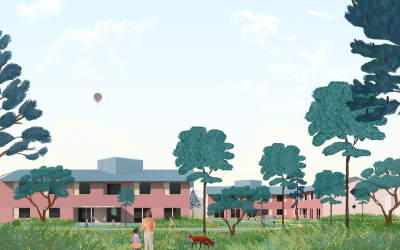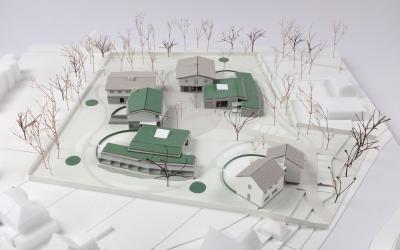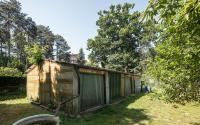Leuven - Care campus Terbank

Award

B-ILD met onderaannemers Fallow (landschap), BAS (stabiliteit) en STir (technieken)
Download design proposalThe contract was awarded to B-ILD with subcontractors Fallow (landscape), BAS (stability) and STir (techniques).
B-ILD’s proposal starts from a broad analysis of the surroundings. The master plan proposes a compact building that, despite its extensive programme, is modest and nestles in the western corner of the site. In this way, the large green inner area with the orchard is safeguarded. A public passageway connects the site to its surroundings, and allows visitors to explore the inner area as one of the neighbourhood’s green spaces. The building links the various living groups together in compact volumes, thus connecting to the grain of the buildings along Sint-Jansbergsesteenweg. The oldest building on the site, the striking villa, is integrated into the design and given a new (neighbourhood) function, so that it remains an important landmark.
Together with the existing living group on the street and the four new living groups a little deeper on the site, the villa forms the new head of the site. The designers create a meeting place for the residents but also for the neighbourhood, with the entrance square as the beating heart of the site. Situating the square in front keeps motorised traffic off the site while ensuring accessibility. In this way, the proposal provides for an open and public part to the south of the site and a rather closed and private part to the north.
The building is conceived as a series of double dwellings (referring to the double dwellings in the neighbouring Ter Elst neighbourhood) to give scale to the different communities. Between each living group a lower intermediate space is provided where all shared functions have a place. By presenting the living groups as massive structures and the communal intermediate spaces as open structures, the design creates a natural legibility and divisibility but also a feeling of small scale, security and homeliness. The arrangement of rooms around a common staircase provides overview for educators and promotes social contact. Each room is unique in orientation and shape.
The conceptual structure leaves room for shifts and adjustments, facilitating cooperation between the design team and the client. With their strong vision and willingness to process, the designers make it possible to incorporate the specific needs of the operation into the design.
Selection

architecten jan de vylder inge vinck
Download design proposal
FELT architectuur & design
Download design proposal
Rosalie Gielis, wissel architectuur studio
Download design proposalProject description
The non-profit association MPC Terbank vzw offers various forms of support for children, adolescents and young adults with mild or moderate mental disabilities, often combined with behavioural and emotional disorders. Through a multidisciplinary operation and a flexible approach, we offer tailor-made support, in close cooperation with the young person and/or close ones or institutions such as the juvenile court.
Terbank has evolved considerably in recent years. In the past, care used to be almost exclusively residential; today, almost half of the young people receive non-residential care. Yet there is still a high demand for residential care for a more complex target group. Our group of residential clients requires a focused, modern and sustainable housing environment, adapted to the care needs of young people with a mental disability, behavioural disorders and extra care needs.
For non-residential clients, i.e. children and young people who rely on ambulatory or mobile support (day care, daytime activities, lodging, holiday care, crisis care, etc.), no specific infrastructure had as yet been developed by Terbank. The non-residential offer was developed within the existing buildings, largely on this site, with limited adaptations. Today, however, we observe that further expansion is not possible without major and expensive adaptations.
Our new care campus must provide space for both residential and non-residential operations, so that Terbank can continue to grow and offer a strong and diverse residential programme in a pleasant and adapted living environment and can better meet the many other care needs. Our campus must be designed with the flexibility and creativity of the young people’s trajectories in mind, and it must be sustainably integrated into the environment.
The assignment includes the all-inclusive study for the site with four living units, solid individual accommodation modules and multipurpose spaces for the multifunctional services. All this should be integrated into a green environment. The outdoor space is intended for green experiences, garden activities, sports and games, etc. and should also offer opportunities to involve people from the neighbourhood.
The project zone is only accessible via a northern plot along Sint-Janbergsesteenweg. No other access road is allowed. The plots will have to be provided with an access road and mains services. On the north and south sides are private buildings; on the east side there is a residential care centre. The newly acquired plot itself is currently an orchard, whose character we want to partially preserve.
At the new site, we want to create a multifunctional care campus with a mix of housing and space for activities. The totality will include the existing residential group (northernmost building), four new housing units for the residents of the residential group, a number of mini-housing units for young people who want to progress to independence, and multifunctional spaces. We want to give part of the new programme a place in the existing characterful building so that it can take up its role as a beacon and landmark on the site.
The site should become a lively entity, with room for central services, day care, supervised visits and leisure experiences in addition to housing. The green environment in which it is embedded will offer residents, temporary residents, visitors, staff and local residents space for meetings, games, sports and other activities.
The assignment consists of a fixed and a conditional part. The fixed part comprises a development plan for the entire site and the design and execution of the first phase with two living units, individual accommodation modules and rooms for the multifunctional services realized. The following principles are important here:
- Accessibility to the site by car is limited. There is room for walking, running, cycling, scooting, etc. on an adapted surface.
- The outdoor space is a sustainable green environment that requires minimum maintenance. The relation of the buildings to the outdoor space and the transitions between private and public areas on the site are key design considerations.
- The various parts of the programme are aligned in a flexible way and form an environment where support is possible in a smooth manner. Consideration must be given to which target groups can live together on the campus but also in what way sufficient privacy can be provided for each target group separately.
- We try to be as self-sufficient as possible within budget feasibility and attach importance to new insights around circular construction.
- A good, workable, ergonomic and robust environment needs to be created, where we can smoothly provide support to a group of adolescents/children with intellectual disabilities, behavioural and emotional developmental disorders, and limited motor problems.
- The buildings and rooms focus on relaxation and trauma-sensitive activities where integrated safety is very important.
- One of these residential groups should be available at weekends for lodging. The layout of the rooms should be planned for dual use in both living units so that weekend lodging can be provided efficiently.
- Important elements in the programme of requirements are rest areas in the context of trauma-sensitive work, but equally a seclusion room in the context of safety.
The conditional part includes the design and execution of the remaining two residential groups. The execution of the conditional part is dependent on available budgets.
Included in the assignment and fee
- architecture
- stability and special techniques
- layout of the surroundings and infrastructure
- EPB and ventilation
- safety coordination
Excluded from the assignment and fee
- topographic surveys (already done)
- soil investigation
- soil-hygiene survey
- archaeological survey
- demolition inventory
- asbestos inventory
Selection conditions
The candidate must be registered with the Order of Architects (or equivalent - see selection guide 2.1.1)
Project team
- At least 1 expert in architecture with 5 years’ experience as project manager on public projects.
3 reference projects
- 1 of the reference projects shows that the candidate has experience in designing a collective housing or care project.
- 1 of the reference projects shows that the candidate has experience in building a project with a specific relationship to the public space.
The following holds for these reference projects:
- Each reference explains what role the designer played in the submitted project.
- References can be built projects as well as projects under construction or in the design phase.
Selection and awards criteria
See the selection guideline
Project details
Project code
OO4605
Official name
All-inclusive study assignment for a new care campus for young people with mental disabilities and behavioural disorders, the realization of two living units, individual accommodation modules and spaces for the multifunctional services (fixed part) and the realization of the next two living units (conditional part) for MPC Terbank in Leuven.
This project is part of the project bundle OO46.
Status
Awarded
Client
Medisch Pedagogisch Centrum Terbank
Site location
Sint-Jansbergsesteenweg 87
3001 Leuven
Belgium
Timing project
- Selection meeting:
- First briefing:
- Second briefing:
- Deadline offers:
- Jury:
Contactperson client
Frederick Basteyns
Contact Team Vlaams Bouwmeester
Jouri De Pelecijn
Award procedure
Competitive procedure with negotiation
External jury member
Johan Anrys
Financial
Construction budget
Excluding VAT
Excluding commission
Commission
Fee for offers
Project type
Function
This project was realized via Open Oproep. Read more about this tool.
Last reviewed on: .

























